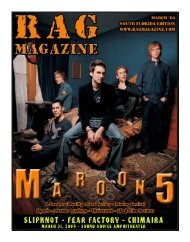have your drums or guitars custom painted by ... - RAG Magazine
have your drums or guitars custom painted by ... - RAG Magazine
have your drums or guitars custom painted by ... - RAG Magazine
You also want an ePaper? Increase the reach of your titles
YUMPU automatically turns print PDFs into web optimized ePapers that Google loves.
The Magdalene Sisters<br />
Miramax, R<br />
The Magdalene Sisters is a powerful unearthing of cinema. That being<br />
said, it’s also a bone-chilling movie to experience –simply because it’s<br />
raw and it’s real and it’s riveting. At its c<strong>or</strong>e, the film is essentially a st<strong>or</strong>y<br />
about honesty; m<strong>or</strong>e specifically, the true barbaric st<strong>or</strong>ies hidden within<br />
the walls of the Catholic-run institutions of Ireland collectively known as<br />
The Magdalene Laundries. Viciously named f<strong>or</strong> Mary Magdalene (the w<strong>or</strong>st<br />
kind of sinner), these asylums existed from the 1800s until as recent as<br />
1996. Under the guise of repentance, prayer, and cleansing souls, the<br />
Catholic Church rabidly took in children that had been shamed and abandoned<br />
<strong>by</strong> their families after having “thought about” <strong>or</strong> “been privy” to m<strong>or</strong>al<br />
crimes; regardless if the supposed behavi<strong>or</strong> was no fault of their own <strong>or</strong><br />
never actually occurred. It was within these merciless institutions of religious<br />
rhet<strong>or</strong>ic and greed that profit-generating sweatshops requiring intensive<br />
lab<strong>or</strong> without pay had been created. B<strong>or</strong>n within the sanctity of a<br />
church that was devoid of any humanity <strong>or</strong> spirituality, these asylums physically<br />
and emotional stripped the legions of women of their hearts and<br />
souls, with many eventually succumbing to their sad, lonely deaths.<br />
After digesting a litany of documented research, Direct<strong>or</strong> Peter Mullan<br />
assembled an authentic screenplay (based on actual testimony), and the<br />
end result artfully exposes the Catholic Church with harrowing accounts of<br />
the sadistic brutality subjected upon women -of all ages- in the name of<br />
religion. The shocking truths unfold in 1964, through the eyes of four, once<br />
unrelated girls, who along with an estimated 30,000 women, find themselves<br />
imprisoned within the façade of faith. Mullan’s visions are crisp,<br />
clear and to the point. Once he unmasks a truth, he moves on to free the next. He utilizes subtle, evocative nuances that jolt <strong>your</strong><br />
senses: from the effective grainy footage that is reminiscent of 1964, to the traditional Irish folk music that magically becomes<br />
audible just as the dialogue fades away and we must abs<strong>or</strong>b every ounce of pain through the victims’ eyes.<br />
The film’s revelations are unyielding and skillfully demonstrate the scarring psychological effects that the women endured day after<br />
day. And <strong>by</strong> preserving this behavi<strong>or</strong> within<br />
a documentary-like atmosphere, Mullan<br />
merely proves to be doing his humanitarian<br />
duty of exposing the ominous system<br />
as it truly occurred -<strong>by</strong> providing an insight<br />
into these women’s incomprehensible<br />
journeys into hell. There are a number<br />
of stand-out perf<strong>or</strong>mances—including<br />
first time (and first rate) actresses<br />
Noone and Duffy, and a haunting Eileen<br />
Walsh. But nothing prepares you f<strong>or</strong> the<br />
wicked viciousness callously delivered <strong>by</strong><br />
Geraldine McEwan as head tyrant Sister<br />
Bridget. McEwan’s caustic perf<strong>or</strong>mance<br />
is so terrifying that her face will haunt you<br />
f<strong>or</strong> days.<br />
After experiencing this tour-de-f<strong>or</strong>ce of<br />
film, DVD extras will be the least of <strong>your</strong><br />
concerns (which is a good thing because<br />
there aren’t any.) However, there is one<br />
gl<strong>or</strong>ious featurette: a fifty-minute documentary<br />
entitled “Sex in a Cold Climate.”<br />
Filmed in 1998, its crux exposes the sinister realities of the Magdalene Laundries through chilling interviews with the once<br />
prisoners/victims now real-life surviv<strong>or</strong>s of these inhumane institutions that cowardly hid behind the facade of religion. Based on<br />
the sadistic subject matter, I’d recommend watching the documentary a few days removed from the film itself. In fact, the documentary<br />
is so evocative, direct<strong>or</strong> Mullan reveals that it inspired him to expose these unspeakable evils to the uninf<strong>or</strong>med public; hence:<br />
The Magdalene Sisters. This is a multifaceted film that deserves, and demands, <strong>your</strong> undivided attention.<br />
<strong>RAG</strong> MAGAZINE • APRIL 2004 • 47
















